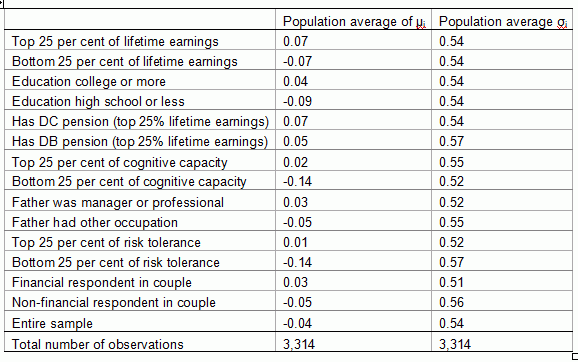Even during the best of economic times, the typical rite-of-passage financial decisions that people face, such as whether to buy a house or save for their pension, are clouded by uncertainty over the future. And these are far from the best of economic times.
In order to make good decisions, or at least avoid disastrous ones, people have to form beliefs about factors that may affect the outcome of their actions and incorporate them into their decisions. This is easier said than done. Indeed, recent history demonstrates that even experts cannot always form adequate beliefs about uncertain outcomes, such as the distribution of returns of mortgage-backed financial assets or underlying real estate prices.
While the consequences of variation in beliefs for aggregate fluctuations can be spectacular and receive the most attention, the consequences of interpersonal differences in beliefs, while less spectacular, are no less important. People with similar lifetime earnings and preferences may end up with very different levels of wealth and lifetime consumption if they make financial decisions that differ systematically. In his presidential address to the American Finance Association, John Campbell (2006) emphasised the need for understanding heterogeneity in household finances. Among other phenomena, he pointed out the strong association in the US between wealth and demographic factors, on the one hand, and stock market participation and asset diversification, on the other hand. In Europe, Christelis et al. (2010) find that the propensity to invest in stock market–based assets is strongly associated with cognitive abilities.
Differences in beliefs can lead to such systematic differences in financial decisions, especially if heterogeneity in beliefs is persistent. Nothing in the fundamentals of microeconomic theory suggests that households’ beliefs have to be uniform or have to be in any way “correct”. In fact, we argue that it is natural to expect systematic differences among people in their beliefs.
In recent work (Kézdi and Willis 2011), we argue that individual beliefs can be heterogeneous as a result of differences in learning histories, which are in turn caused by differences in returns to, and costs of, learning (as well as in initial conditions). People learn about finance in general, and the stochastic process of returns in particular. The value of learning is proportional to savings, but the costs are fixed. As a result, other things equal, people with higher earnings prospects should learn more than people with lower income prospects, and those with defined benefits-type pensions, such as social security, should learn less. The costs of learning and general attitudes may also be heterogeneous, creating additional heterogeneity in learning outcomes. Initial conditions matter, too. Those with very low expectations will be less likely to learn and will see their beliefs unchanged. In the end, those who learn will revise their initial beliefs to be more precise, closer to what historical series would imply, and learning makes beliefs less heterogeneous. This is a human capital explanation applied to financial knowledge (as in Delavande et al. 2008). It is also an application of the information choice theory of Laura Veldkamp (2011).
But how can we measure beliefs and how can we assess the causes and consequences of differences in beliefs? Inferring beliefs from decisions is impossible without making assumptions on preferences. (By symmetry, inferring preferences from decisions under uncertainty is also impossible without making assumptions about beliefs.) There is a small but growing body of literature that finds the solution to this problem in measuring people’s beliefs in a direct way. In other words, by asking them. Some papers in this literature use survey questions about probabilistic expectations, such as: “What is the percent chance that you will live to be 75 or more?” Charles Manski (2004) provides an excellent argument for directly measuring expectations and Michael Hurd (2009) summarises the research using survey probability questions and the open questions in that literature.
With all their benefits, probability questions are not without problems. Answers to such questions elicited in a survey situation are likely to be different from the beliefs that enter into a real life investment decision. The survey response to a probability question takes less than thirty seconds, on average, and there are practically no incentives to get the answers right. The data we can use is therefore likely to be very noisy.
In our analysis of stock market expectations, we used answers to two questions from the 2002 survey of the Health and Retirement Study (a large panel survey of people aged over 50 in the US). The two questions are:
- By next year at this time, what is the percent chance that mutual fund shares invested in blue chip stocks, like those in the Dow Jones Industrial Average, will be worth more than they are today?
- By next year at this time, what is the chance they will have grown by 10% or more?
Besides strong systematic variation in line with our arguments, the answers to these questions show some disturbing patterns. Empirical evidence suggests that most of those patterns are consistent with inattention and can be modelled as random (although nonlinear) survey noise. Our analysis is based on an econometric model that separates survey noise from relevant heterogeneity and estimates the relevant belief parameters from the probability answers.
Our estimates show that, on average, respondents have low expectations and high perceived risk. The data does not allow for capturing all the differences in subjective risk perceptions. But the level of expectations shows substantial and systematic heterogeneity, as illustrated in Table 1 below (reproduced from our paper). For example, we estimate that the majority of college-educated respondents with top 25% lifetime earnings and a defined contribution pension plan have expectations that, in 2002, were very much in line with what historical returns would imply. Our findings suggest that those people who should learn about returns in the stock market do learn and, given their beliefs, those people who should invest do invest. But people who did not have incentives to learn were very pessimistic about stock market returns, even in 2002. Our results also suggest that beliefs are important in explaining why some demographic groups, such as African Americans or single women, are less likely to hold stocks than others with similar education, lifetime earnings, and risk preferences.
Table 1. Estimated beliefs about stock market returns and risk by personal characteristics
Sample: Health and Retirement Study, wave 2002. Respondents of age 55 through 64 (partner also 55-64)
μi and σi: predicted values of the subjective mean and subjective standard deviation of the one-year ahead log return
The financial crisis not only highlighted the importance of understanding belief formation, but it also had genuine effects on beliefs. In recent research together with Péter Hudomiet (Hudomiet et al 2011), we use data from the 2008 wave of the Health and Retirement Study to compare stock market beliefs of households before and after the fall of Lehman Brothers which led to a collapse of stock prices. Our results show little effect on expectations on average, some increase in perceived risk, but a substantial increase in interpersonal disagreement about the direction and magnitude of expected stock market returns.
We found larger increases in disagreement among the stockholders, the more informed, and those with higher cognitive capacity. These groups are, in general, characterised by beliefs that are not only closer to historical averages, but are also more homogenous. These facts are consistent with the notion that more sophisticated households share similar knowledge, but vary greatly in the “mental models” they use to convert news of major events into expectations about the future.
Understanding the sources and consequences of the heterogeneity in households’ beliefs is important for many reasons. The small but growing literature focusing on that heterogeneity has made progress both on substantive and on methodological questions. We believe that further important discoveries lie ahead of this line of research.
References
Campbell, John Y (2006), "Household Finance", The Journal of Finance, 61(4):1553-1604.
Christelis, Dimitris, Tullio Jappelli, and Mario Padula (2010), “Cognitive abilities and portfolio choice”, European Economic Review, 54:18-39.
Delavande, Adeline, SusannRohwedder, and Robert J. Willis (2008), "Preparation for Retirement, Financial Literacy and Cognitive Resources", Michigan Retirement Research Center Working Paper No. 2008-190.
Hudomiet, Péter, Gábor Kézdi and Robert J Willis (2011), "Stock Market Crash and Expectations of American Households", Journal of Applied Econometrics, 26(3):393-415.
Hurd, Michael D (2009), “Subjective Probabilities in Household Surveys”, Annual Review of Economics, 1:543-562
Kézdi, Gábor and Robert J Willis (2011), “Household stock market beliefs and learning”, NBER Working Paper No. 17614.
Manski, Charkes F. (2004), "Measuring Expectations," Econometrica, 72, 1329-1376.
Veldkamp, Laura (2011), Information Choice in Macroeconomics and Finance. Princeton University Press



